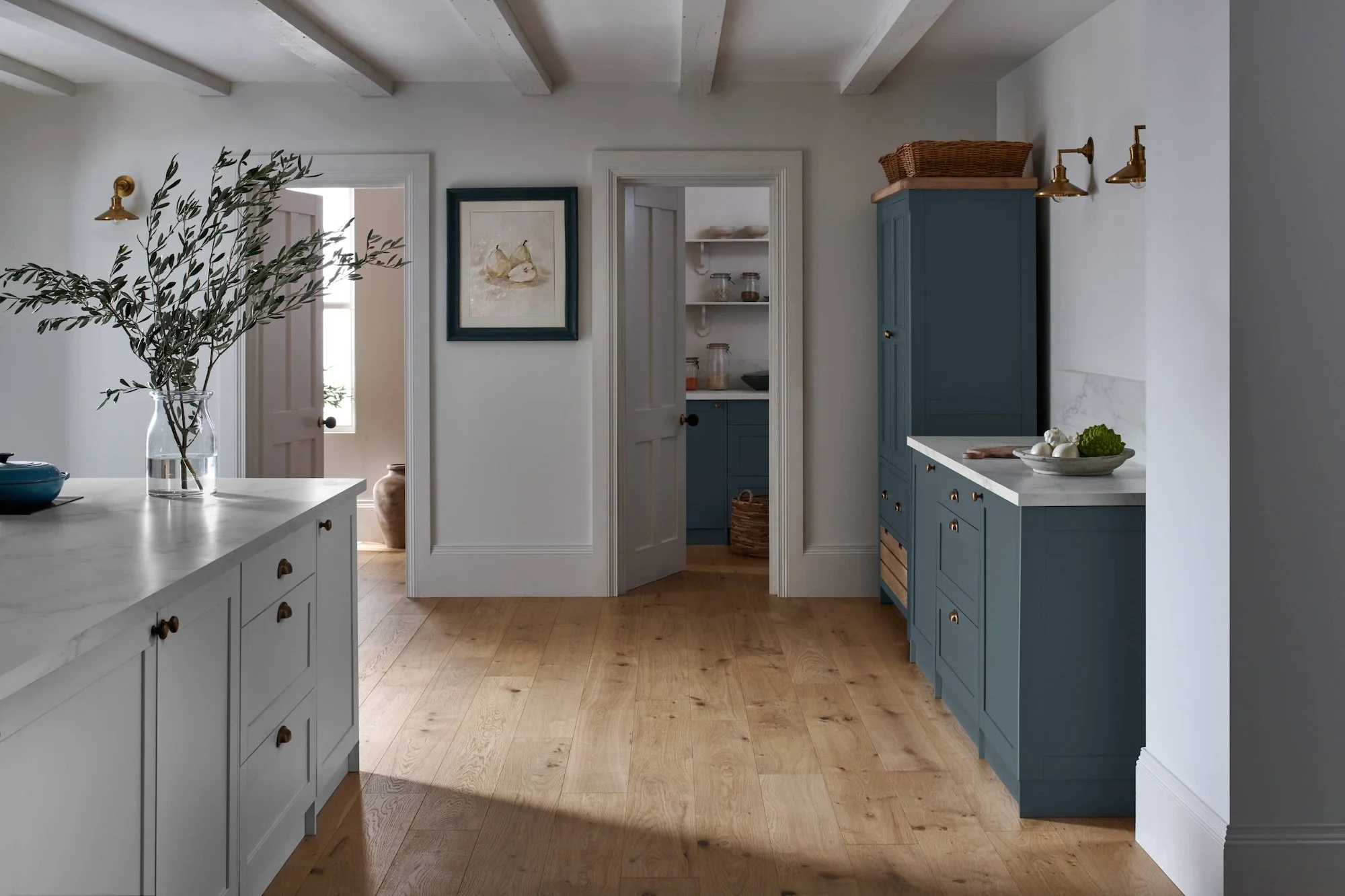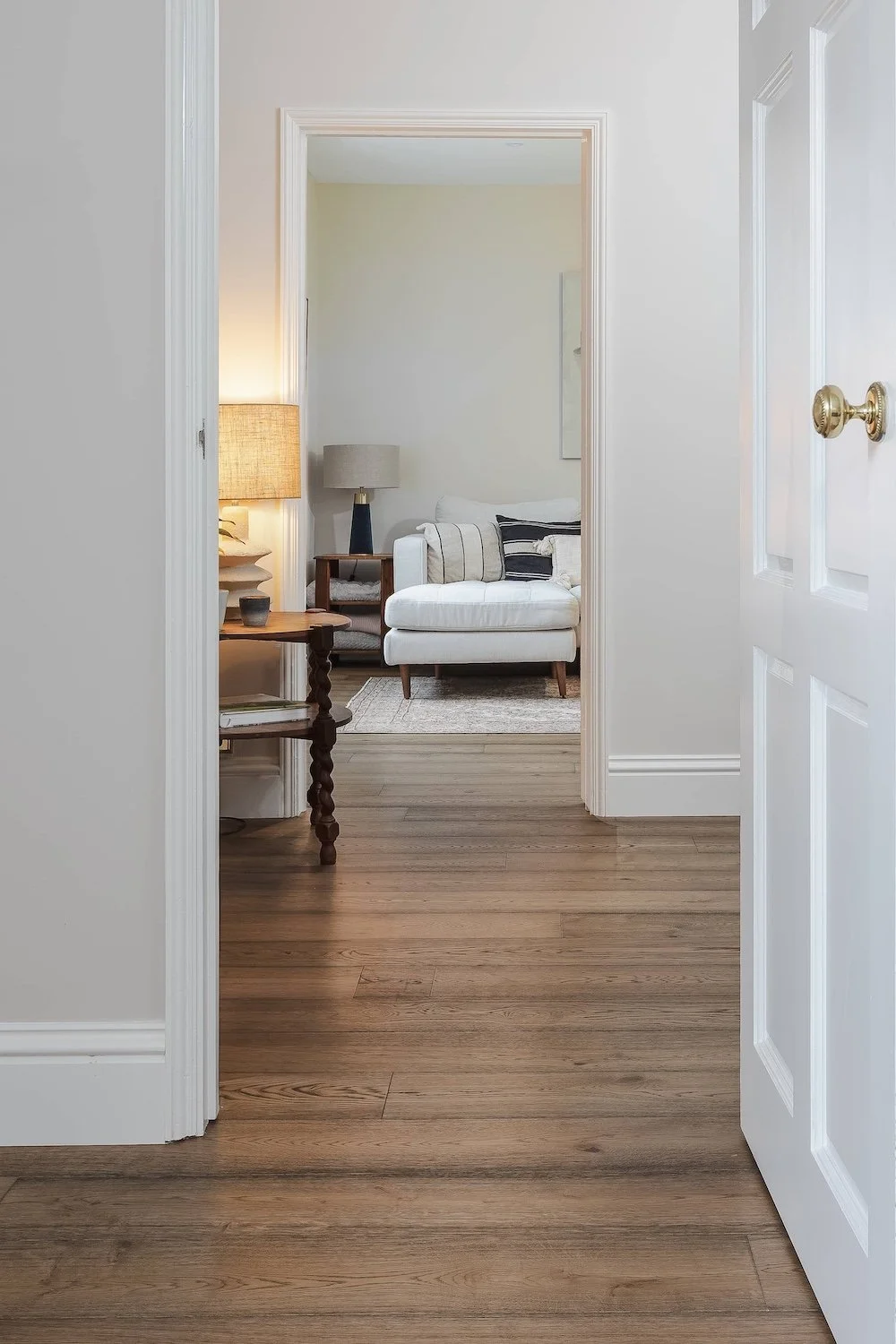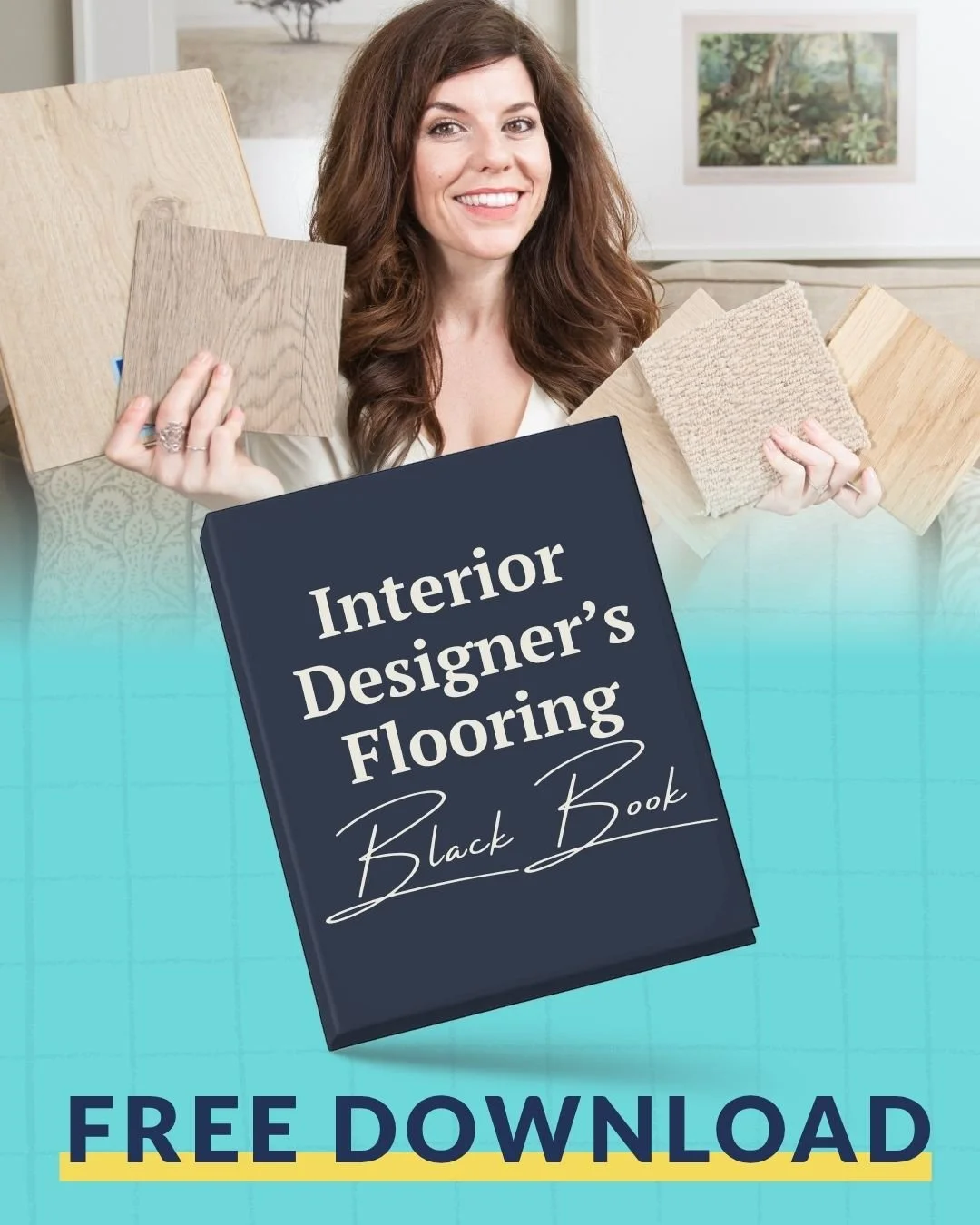Engineered wood or LVT floors – which is worth it?
When you're spending hundreds – sometimes thousands – on new flooring, the last thing you want is something that’s prone to chips and scratches. Cue the instant regret when you drop something and it gets scuffed 😭
If you're trying to decide between Luxury Vinyl Tile (LVT) and Engineered Wood Flooring, you're right to give it a lot of thought. It's one of the most common questions I get asked by clients and that’s why today, I’m breaking down everything you need to know before you commit 💰
This post will help you weigh up the pros and cons and pick the floor that suits your budget, lifestyle and taste.
Spoiler alert: There’s a standout winner – but I have to explain 🫢
engineered wood (the stonehaven rustic oak by woodpecker flooring)
LVT vs Engineered Wood: What’s the difference?
Before we talk design and performance, it’s important to understand how these two floors are made. Because while they can look quite similar once they’re freshly installed, underneath, they’re worlds apart.
LVT (Luxury Vinyl Tile) is made from layers of vinyl, with a printed top layer that mimics the look and texture of real wood. It’s a plastic-based product, which makes it waterproof and highly durable. If you’re looking for Bathroom floors, bingo 👌🏻
Engineered Wood Flooring has a real wood veneer on top and multiple layers of plywood or high-density fibreboard through its center. It’s real wood, just in a thinner layer, supported by a stable, more rigid core to prevent warping.
So in short: LVT is plastic, Engineered Wood is real wood. That’s the core distinction to keep in mind as we dive deeper.
This is lvt (the berwick oak by amtico)
this is engineered wood (the kingsley by v4 flooring)
Engineered Wood or LVT: Which is the best design?
If you’re after a warm, authentic, timeless look (especially in living spaces that don’t require waterproof flooring) engineered wood usually wins.
The natural variation in colour, the tactile grain, and the warmth underfoot gives a level of luxury that’s hard to beat. For heritage homes or spaces where character matters, engineered wood adds long-term value and style.
But I wouldn’t go writing off LVT in a hurry. Oh no.
Because high-end LVT options are incredibly convincing and virtually look like real wood nowadays. Many LVT floors have textured finishes and bevelled edges that mirror real timber superbly. Plus, LVT planks tend to be thinner making LVT ideal for rooms where you need to tuck the flooring beneath existing doors and skirting.
🏆 My design verdict: Engineered Wood wins on design but premium LVT is catching up fast, and is a brilliant option for kitchens, bathrooms, and projects that require waterproof solutions.
LVT or Engineered Wood: Which is more durable & family friendly?
This is where LVT absolutely shines in my opinion.
Waterproof? Yep ✅
Scratch-resistant? Oh yes ✅
Suitable for kitchens, bathrooms, utility rooms and pretty much any room in the house? Ding, ding, ding ✅
LVT is so hard-wearing and forgiving that a contractor once dropped – and then stood on! – a bunch of nails, skidded across the floor with them and it didn’t leave a mark. If you’ve got kids, pets, or just want peace of mind, LVT is a dream to have in your home. Believe me.
In terms of spills and stains, engineered wood, while more durable than solid wood, doesn’t like water in the same way LVT can cope with it. It can be used in kitchens if chosen and installed with care (and the finish is protective), but in bathrooms, engineered wood is generally not recommended.
🏆 My verdict on durability: LVT is the clear winner here. If scratch resistance and water resistance are high on your priority list, this is the floor of your dreams.
What about maintenance? Does LVT or Engineered Wood last longer?
This one’s a bit more nuanced.
LVT is low-maintenance, no doubt about it. There’s no refinishing required and a simple mop and you're good.
Engineered Wood needs more care but it can also improve with age (if you love the lived in feel wood brings – I know I do!) You can sand and refinish it once or twice depending on the top layer thickness, which adds to its lifespan and also gives you a bit of insurance if scratches and dinks happen. LVT isn’t as easy to patch repair like wood is.
It really comes down to your preference…
Do you want a floor you never have to worry about? → Go for LVT
Or do you want a floor that wears in beautifully over time and can be refreshed instead of replaced? → Engineered Wood is the one
🏆 My verdict on which lasts longer: Ooof now that’s a hard one, but I have to say engineered wood wins by a margin since it ages beautifully with time.
Is LVT cheaper than engineered wood? Breaking down costs
Generally speaking, LVT is more budget-friendly. Not just in terms of materials, but also installation. So if you’re doing a room refresh, you want a good quality floor but you need to be price conscious, it could be the better option for you.
Note here: LVT isn’t the most affordable floor for those of us on a very tight budget. It’s worth keeping in mind floors like laminate if you’re really tightening the purse strings.
Engineered wood can be pricier especially if you go for premium finishes, wide planks or herringbone/parquet patterns (which I recommend you do!). That said, don’t assume it’s always more expensive than LVT and get quotes for all the floors you like so you can compare them.
In fact, one of my clients recently saved £50 per square metre just by calling different local flooring retailers for quotes on a specific engineered floor she wanted. The difference added up fast.
🏆My verdict on cost: If budget is tight, go LVT. But always compare both and get multiple quotes.
Which is better for the planet? Engineered wood or LVT?
OK let’s talk eco.
Engineered wood is the more environmentally-friendly choice out of these two floor types when you choose FSC-certified options. But keep in mind other floor types like Cork, or reclaimed timber will be more sustainable than both of these options.
LVT, being plastic-based, isn’t great for the planet. It can off-gas after installation and many homeowners complain it has a funky smell which leaves after a few days (it’s quite normal for this to happen so air your home after it is fitted). Also, LVT is harder to recycle at the end of its lifespan. So if sustainability is a top priority for you, this may factor heavily into your decision.
🏆 My verdict on sustainability: Engineered wood is the more sustainable choice 👌🏻 But if sustainability is a high priority in your renovation, floors like cork, reclaimed timber – or reviving existing flooring – are worth considering.
So, which floor do I recommend overall?
Honestly, I just can’t choose one overall because we all have unique homes, design taste and needs. In my client’s designs I use Engineered wood as regularly as LVT.
However! For my own personal projects, I think I sway more towards LVT. Especially the more premium options that look virtually like wood but with a very low maintenance record.
Are you wondering where to shop? These are the floors I propose to clients👇🏻
I always want to over-deliver and help my readers, which is why I created a spreadsheet containing the actual floors I propose in client projects – it’s my Flooring Black Book. There are a mix of LVT and Engineered Wood options you should consider buying (some I’ve spent years trying to find) as well as installation tips to get the best result with your floor.
Download my flooring black book – it includes my vetted flooring options with UK and US suppliers across LVT and Engineered Wood.
A final word of advice:
Remember your flooring sets the tone for your entire space and needs to look great years from now. So don’t rush your decision, order samples and make sure it works for your lifestyle, your renovation vision, and your budget.
👉 Click here to download the floors I recommend to clients [spreadsheet]
It’s free and it includes the LVT & Engineered Wood options I propose to clients in my projects, with supplier links for UK and US.
Want help planning your renovation with confidence? I share weekly advice to help you avoid costly mistakes, save money, and make decisions like a pro.
Subscribe to my YouTube channel or check out my online renovation courses if you’re ready to plan your dream home the smart way.
Thank you so much for reading, I hope this helped you and I’m rooting for you and your renovation!
Fi




